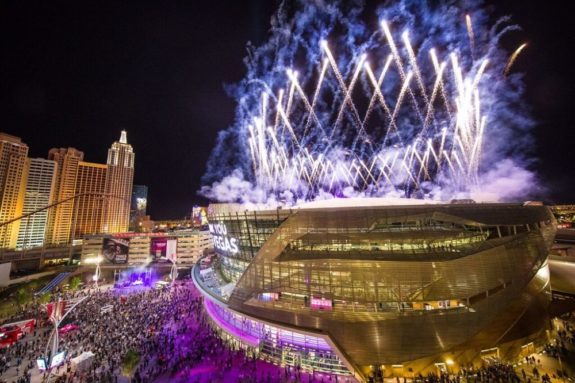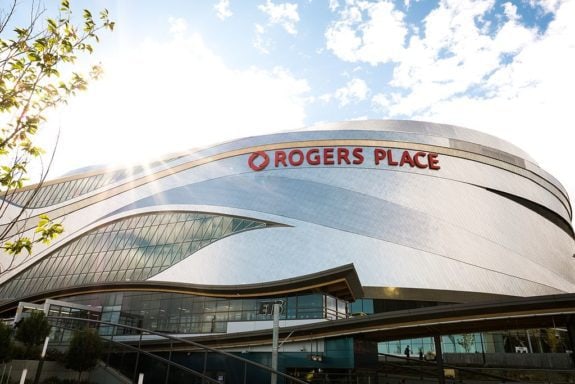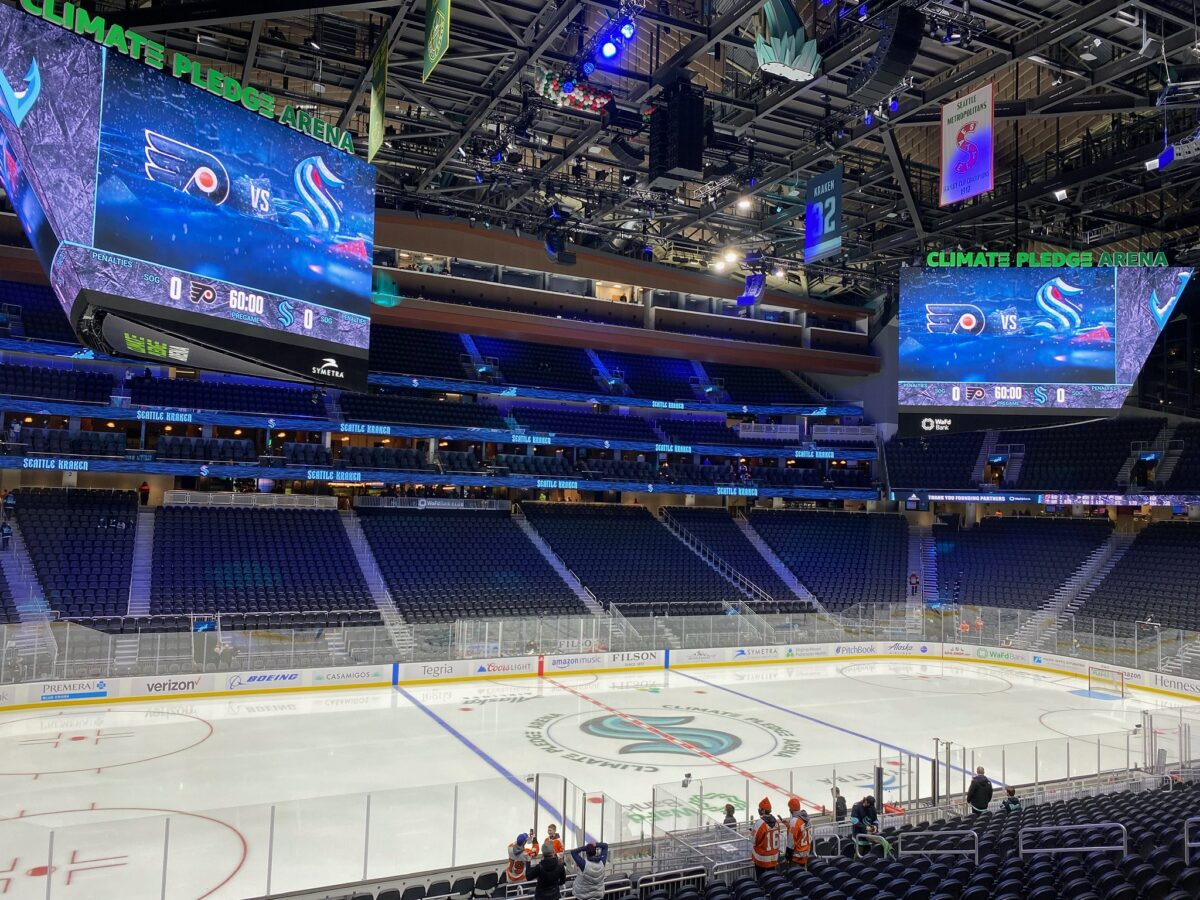Last week, I wrote an article discussing five NHL Arenas that need upgrades. Now, I’ll look on the bright side and discuss some of the NHL’s best facilities. I’ll review some bells and whistles that set these arenas apart and the unique features that make them iconic.
T-Mobile Arena
Opening in 2016, T-Mobile Arena has quickly become one of North America’s best arenas and entertainment venues. In terms of location, it doesn’t get any better. It sits just west of the Las Vegas Strip, one of the biggest entertainment hubs in the country. The surrounding casinos, hotels, and bars make taking in a Golden Knights game part of a fun night on the town.

The exterior design of this arena features all the glitz and glam people have come to expect from Vegas. It has a futuristic design featuring neon lights, digital billboards, and massive windows. The main bowl contains comfy seats and a variety of luxury seating options. One of the upper bowl end zones includes a castle where the DJ and other live performers entertain fans throughout the game. The pregame theatrics are an unmatched spectacle among NHL teams. T-Mobile Arena is more than just a hockey venue; it creates a unique entertainment experience for every game.
Related: Get Loud! Top 10 NHL Arena Atmospheres
T-Mobile Arena is one of the pricier places to see a hockey game in the NHL, both in terms of tickets and concession prices. The main doors on one side of the arena can also make for an inconvenient walk to the exit at the end of the game. But besides minor flaws, this is a perfect fortress for the Golden Knights and their enthusiastic fans.
Rogers Place
Built as the centrepiece of Edmonton’s new ‘Ice District,’ Rogers Place has been the home of Connor McDavid and Leon Draisaitl for eight years. Ice District has built up an outdoor plaza nicknamed ‘The Moss Pit’ by fans in honour of the late Joey Moss. Surrounding the Plaza are bars, restaurants, a hotel, and more developments being added each year. The arena also has an attached casino and a community rink. These developments have made for a much better location than the Edmonton Oilers’ former home at Northlands.

As for the building itself, the chrome exterior and ultramodern concourses give Rogers Place a futuristic aesthetic. One of its unique features is a massive extension of the building that contains a bar and a grandiose main entrance. It also gives the arena an Oil-drop shape, which is a fantastic touch. The arena has everything one could want in a modern venue, including a plethora of premium seating, drinking rails, sit-down restaurants, and a massive HD scoreboard.
Regarding the negatives, my main gripe with Rogers Place is how ‘corporate’ it is. There are almost too many exclusive club sections around the arena; the average Joe sitting in a regular seat will never truly experience the venue in its full glory. The concession options also aren’t entirely up to par with the offerings in a few other NHL cities like New York and Vegas. Overall, the Oilers have a proper state-of-the-art facility to call home, and the surrounding areas will continue to evolve.
Bell Centre
When NHL players are asked which arena they enjoy playing in the most, the Bell Centre in Montreal is one of the most frequent responses. It makes sense; the arena is a modern-day classic. One of the most interesting features of the building is the steep rows of seating that create an intimidating atmosphere where the fans appear to be right on top of the players. Add the noisy and passionate Montreal Canadiens fanbase, and you have a truly one-of-a-kind experience.
The Bell Centre is nearly 30 years old but has aged like a fine wine. The sight lines are fantastic, and the concessions contain some local flavour. It does suffer, however, from being built on a small footprint. While the footprint is part of the reason for the steep seating arrangement people have come to love, it’s also the reason behind the somewhat cramped concourses. The exterior design of the building is nothing to write home about, either.

Bell Centre has become a must-visit hockey venue despite lacking a few modern features of brand-new arenas. Thanks to the Habs’ storied history, the pristine ice, and massive capacity, the arena has a certain aura that makes it undeniably great.
Bridgestone Arena
We’ve discussed location as a big plus for a few of these arenas, and Nashville’s Broadway might be the one place that can rival the Vegas Strip. Bridgestone Arena, home of the Nashville Predators, is located in the heart of Nashville’s bustling entertainment district. Bars and live music venues surround the arena, making for an excellent night out on the town before and after watching a Predators game.
Sign up for our NHL History Substack newsletter
The arena has a unique and somewhat wacky design — the exterior looks like a flying saucer with a radio tower connected to it. Bridgestone Arena is oozing with character in an age where most arena designs are more or less the same. It features a split upper deck design on the interior bowl and has a unique scoreboard with sabretooth fangs on each corner.
Like Vegas, going to a game in Nashville is a complete entertainment experience. A stage behind one of the goals features live music performances throughout the game. Unique fan chants give off a European soccer vibe that the NHL could use more of. Bridgestone Arena is one of the older buildings on this list, so it does lack a few bells and whistles that some of these other arenas have, but it makes up for that with charm and a fantastic gameday experience.
Climate Pledge Arena
The most sustainable arena in the NHL is also one of the most unique. The concourse features digital walls that change their displays, creating a futuristic atmosphere. A massive window lets natural light into the main bowl, and the two scoreboards overtop each end of the ice are one of a kind.

The arena is built into the ground much deeper than most other venues. It was essentially rebuilt underneath the roof of the old KeyArena. It doesn’t look as glorious from the outside as T-Mobile Arena or Rogers Place, but it’s certainly different. Everything from the food offerings to the goal horn and the music has a local touch that makes games at Climate Pledge Arena stand out.
Unfortunately, the building has a somewhat confusing concourse. It is more challenging to find your way around than it is in most arenas. It’s also one of the most expensive venues in the NHL regarding food and drinks, so try to avoid showing up on an empty stomach.
Honourable Mentions:
UBS Arena: The New York Islanders have a stunning home in UBS Arena, boasting a beautiful brick exterior design. While the main bowl features nothing too groundbreaking, it recreates the cozy atmosphere of their old barn. The concourses are spacious, but concession prices are ridiculous. It’s a common problem, but the New York teams seem to have it especially rough. UBS Arena will host the 2026 NHL All-Star Game, which speaks to how well-received the facility is.
Madison Square Garden: The world’s most famous arena has such a rich history that it deserves a mention. It isn’t exactly Taylor-made for hockey, though, and some of the effects of its age are hard to ignore, causing it to fall just short of the top five.
Little Caesars Arena: This arena is beautiful and features the same modern amenities as other brand-new Arenas. The colour-changing ceiling is a unique touch that gives it some extra flare. The poor upper deck seating was the biggest reason I left it off the list. Fans have complained about the lack of legroom and overall cramped feeling, which is disappointing for those who can’t afford the wider seats.
Amalie Arena: This building is a little on the older side and has a slightly dated seating arrangement, but Amalie has a lot of unique elements that make it one of the better arenas in the league. The giant organ in the upper deck and the Tesla coils add to the game presentation. The concourses and concessions are also very modern for an arena built in the 90s.
